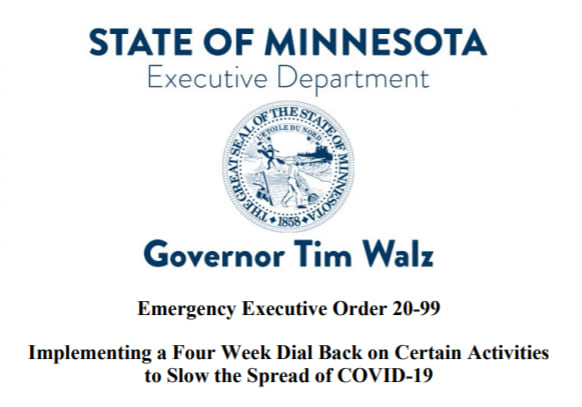Minnesotans, we need to buckle down.
Executive Order 20-99 ~ Implementing a Four Week Dial Back on Certain Activities to Slow the Spread of COVID-19 ~ Last Modified: November 18, 2020 These restrictions are significant and difficult, but this is not the “Stay-atHome” Order that Minnesotans saw in March and April.
"Minnesota’s rate of “community spread”—meaning those cases that MDH cannot link to another case or a source of exposure—is particularly concerning. At least one third of all new COVID-19 infections in Minnesota have no known source...The virus is everywhere, meaning that every interaction we havewith people outside of our households poses a risk of transmission. "
Starting Saturday, Nov. 21, Governor of Minnesota, Tim Walz, ordered new restrictions for bars and restaurants, closing them to the public for service for four weeks to slow the spread of COVID-19 in the state. Bars and restaurants can still do takeout services during the closure period.
Walz still wants anyone who can work from home to do so. He is issuing a new executive order for employees returning to work that will protect them from discrimination or retaliation if they raise concerns about workplace safety.
Houses of worship can open at 50% capacity.
Places such as movie theaters, bowling alleys, concert venues and fitness centers are part of the temporary, four-week closure. Businesses such as hair salons and barber shops remain essential services now, but they can only operate at 50% capacity, and employees must wear masks and other protective equipment when working with a customer. Customers must also be masked.
Organized Youth Sports organizations and programs must stop all in-person activities — including practices, group workouts, games, and tournaments — during a four-week pause announced by the governor.
The state’s policy is to encourage learning in the classroom because, apart from the instructional benefits, it helps children with personal and social development. However, the decision is left up to each school district in consultation with health and education officials. Schools can switch to distance learning or a combination of both in-person and online learning to keep students and staff safe from COVID-19. One big factor will be the COVID-19 infection rate in each county. Using data compiled by the Minnesota Department of Health, the guidelines set out five scenarios depending on the infection rate over the previous two weeks, with classroom learning for the lowest rates and distance learning for the highest. In between will be hybrid models. These are guidelines, not mandates, and each district can take a different approach based on its unique circumstances. Schools must also take into consideration the physical layout of their buildings, including filtration systems.
How about REAL ESTATE? Real Estate transaction are still essential, but only meetings that are essential to happen in person, should. All other meetings should be virtual.
Anyone who "willfully" violates the order is guilty of a misdemeanor, punishable by up to 90 days in a jail or a fine of up to $1,000. Any business owner or manager who requires an employee to violate the order can be punished with a gross misdemeanor and a fine of up to $3,000 or one year imprisonment. Attorney General Keith Ellison and city and county attorneys can also seek civil penalties against businesses that violate the order.



